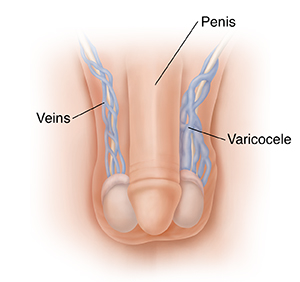Understanding Varicocele Embolization
Varicocele embolization is a procedure used to treat an enlarged vein in the scrotum. Your health care provider will use a long thin tube (catheter) and a tiny coil or medicine to block the flow of blood to the varicocele. The blood will then flow in a different direction. The varicocele will go away.

What is a varicocele?
A varicocele is an abnormal enlargement (dilation) of a vein in the scrotum. These veins are found along the cord (spermatic cord) that holds up the testicles.
Your scrotum is the sac that contains your testes. Sperm are made in the testes. Sperm travel in semen from the testes through tiny tubes (ducts) and to the urethra.
A varicocele is like a varicose vein in the leg. Normally, valves inside the veins keep blood flowing in one direction. Sometimes the valves don't work well. This is the most common cause of a varicocele. Varicoceles often form during puberty.
Why varicocele embolization is done
A varicocele usually doesn't cause symptoms. Your health care provider may find a varicocele during an exam of your scrotum and testes.
You may need a varicocele embolization if you:
-
Have symptoms, such as pain or swelling.
-
Aren't able to have a child (infertile).
-
Want to prevent problems, such as infertility or shrinking (atrophy) of the testes.
Embolization is one treatment for a varicocele. Surgery can also be done to treat a varicocele. Talk with your provider about which treatment is best for you.
How varicocele embolization is done
Your procedure will be done by an interventional radiologist. This is a health care provider who specializes in image-guided procedures.
This procedure is often done on an outpatient basis. But some patients may require admission to the hospital after the procedure. Ask your doctor if you will need to be admitted.
Your provider will put a needle into a large vein in your groin. Then they place a catheter into this vein to the site of the varicocele.
Your provider will use the catheter to put a small coil or a special liquid into the affected vein to block it.
Risks of varicocele embolization
All procedures have some risks. The risks of this procedure include:
-
Infection.
-
Bleeding.
-
Allergic reaction to medicine used during the procedure.
-
Movement of the coil used to block the varicocele.
-
Back pain.
-
Swelling of the scrotum or vein.
-
Failure of the procedure to work.
-
Return of the varicocele.
Your risk may vary depending on your age and overall health. It also depends on the location and severity of the varicocele. Talk with your provider about which risks apply most to you.
Online Medical Reviewer:
Lalitha Kadali Researcher
Online Medical Reviewer:
Melinda Murray Ratini DO
Online Medical Reviewer:
Raymond Kent Turley BSN MSN RN
Date Last Reviewed:
11/1/2024
© 2000-2025 The StayWell Company, LLC. All rights reserved. This information is not intended as a substitute for professional medical care. Always follow your healthcare professional's instructions.